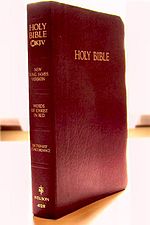- New King James Version
-
For other uses of King James Version, see King James Version (disambiguation).
New King James Version 
Full name: New King James Version Abbreviation: NKJV Complete Bible published: 1982 Derived from: King James Version Textual basis: NT: Textus Receptus, similar to the Byzantine text-type. OT: Masoretic Text with Septuagint influence Translation type: Formal Equivalence Copyright status: Copyright 1979, 1980, 1982 Thomas Nelson, Inc. Genesis 1:1-3In the beginning God created the heavens and the earth. The earth was without form, and void; and darkness was on the face of the deep. And the Spirit of God was hovering over the face of the waters. Then God said, "Let there be light"; and there was light.
Genesis 1:1 in other translationsFor God so loved the world that He gave His only begotten Son, that whoever believes in Him should not perish but have everlasting life.
John 3:16 in other translationsThe New King James Version (NKJV) is a modern translation of the Bible published by Thomas Nelson, Inc.[1] The New Testament was published in 1979. The Psalms in 1980. The full Bible was published in 1982. It took a total of 7 years to complete.[2] The anglicized edition was originally known as the Revised Authorized Version, but the NKJV title is now used universally.
The Bible in English Old English (pre-1066) Middle English (1066–1500) Early Modern English (1500–1800) Modern Christian (1800–) Modern Jewish (1853–) Miscellaneous Contents
History
The NKJV translation project was conceived by Arthur Farstad. It was inaugurated in 1975 with two meetings (Nashville and Chicago) of 130 biblical scholars, pastors, and theologians. The men who were invited prepared the guidelines for the NKJV.
The aim of its translators was to update the vocabulary and grammar of the King James Version, while preserving the classic style and literary beauty of the original 1611 KJV version. The 130 translators believed in unyielding faithfulness to the original Greek, Aramaic, and Hebrew texts including the Dead Sea Scrolls. Also agreed upon for most New King James Bibles was, easier event descriptions, history of each book, and added dictionary and updated concordance.
Features
According to the preface of the New King James Version (p. v-vi), the NKJV uses the 1967/1977 Stuttgart edition of the Biblia Hebraica for the Old Testament, with frequent comparisons made to the Ben Hayyim edition of the Mikraot Gedolot published by Bomberg in 1524–25, which was used for the King James Version. Both the Old Testament text of the NKJV and that of the KJV come from the ben Asher text (known as the Masoretic Text). However, the 1967/1977 Stuttgart edition of the Biblia Hebraica used by the NKJV uses an earlier manuscript (the Leningrad Manuscript B19a) than that of the KJV.
The New King James Version also uses the Textus Receptus ("Received Text") for the New Testament, just as the original King James Version had used.
Translation philosophy
The translators have sought to follow the principles of translation used in the original King James Version, which the NKJV revisers call "complete equivalence" in contrast to "dynamic equivalence" used by many other modern translations. The task of updating the English of the KJV involved significant changes in word order, grammar, vocabulary, and spelling. One of the most significant features of the NKJV was its abandonment of the historic second person pronouns “thou”, "thee", “ye”, “thy”, and “thine”. Verb forms were also modernized in the NKJV (for example, "speaks" rather than "speaketh").
The Executive Editor of the NKJV, Arthur L. Farstad, addressed textual concerns in a book explaining the NKJV translation philosophy.[3] While defending the Majority Text (also called the Byzantine text-type), and admitting that the Textus Receptus is inferior to the Majority Text, he noted (p. 114) that the NKJV references significant discrepancies among text types in its marginal notes: "None of the three [textual] traditions on every page of the New Testament ... is labeled 'best' or 'most reliable.' The reader is permitted to make up his or her own mind about the correct reading."[3]
Circulation
An unabridged audio version (Audiobook) called "The Word of Promise Audio Bible" has been produced by the publisher. It is narrated by well-known celebrities and fully dramatized with music and sound effects[4]
Gideons International, an organization that places Bibles in hotels and hospitals, uses the NKJV translation.[5]
References
- ^ The Holy Bible, New King James Version. Nashville: Broadman & Holman Publishers. 1982. ISBN 15558194320.
- ^ "New King James Version (NKJV Bible)". The Bible Gatewa. http://www.biblegateway.com/versions/New-King-James-Version-NKJV-Bible. Retrieved 2011-09-14.
- ^ a b Arthur L. Farstad, "The New King James Version in the Great Tradition," 2nd edition, 1989, Thomas Nelson Publishers, ISBN 0-8407-3148-5.
- ^ Groves, Martha (16 November 2009), "BELIEFS : Stars lined up for elaborate audio Bible", Los Angeles Times (Los Angeles), http://articles.latimes.com/2009/nov/16/local/me-beliefs16
- ^ Klein, Peter. The Catholic Source Book, p. 146, Harcourt Religious Publishers, 2000. ISBN 0159506530
External links
- Thomas Nelson, Inc. Publishers website
Categories:- 1982 books
- King James Only movement
- English Bible translations
- 1982 in religion
Wikimedia Foundation. 2010.
